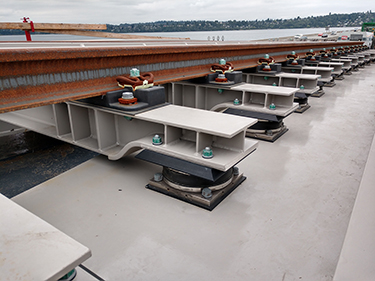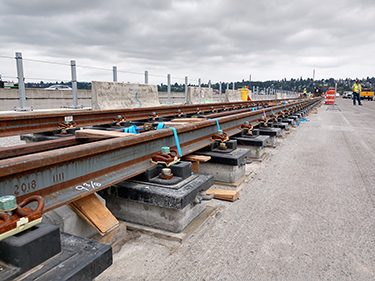|
Subscribe / Renew |
|
|
Contact Us |
|
| ► Subscribe to our Free Weekly Newsletter | |
| home | Welcome, sign in or click here to subscribe. | login |
Construction
| |
July 24, 2019
Crews lay down track atop I-90 floating bridge
Journal Construction Editor
Crews have installed one of the eight specialized track sections that will allow light rail trains to cross the Interstate 90 floating bridge.
The 43-foot-long sections — called track bridges — will carry rail from the fixed ends of the Homer M. Hadley bridge to its floating part. They were designed to move with the bridge, which can flex in six different directions. They also spread movement over a longer distance than the existing expansion joints.
“This has not been done anywhere else in the world,” said John Sleavin, deputy project director in charge of final design at Sound Transit, during a Tuesday media tour of the bridge.
Sleavin said he has been working on the project for about a decade and its design borrows a few elements from the building world, namely seismic isolators.
Sound Transit partnered with WSP USA and Jesse Engineering of Tacoma to design and build two full-scale prototypes.
Those prototypes, and two Link light rail trains, were shipped to the Transportation Technology Center in Colorado for testing that included repeatedly running the trains at 55 mph over the track bridges. The center is operated by the Federal Railroad Administration and the Association of American Railroads to test new technologies.
Both prototypes are being used on the bridge and the remaining six track bridges are being built in Tacoma.
Each track bridge will be secured to a fixed part of the existing bridge and will slide on bearings atop the floating section.
Sleavin said they are designed to pull apart, like a carpenter's miter joint, in the unlikely event of a quick drop in the water level of Lake Washington. This is expected to help save the main bridge.
All of the track bridges are scheduled to be in place by year end.
Laying track on a floating bridge has additional challenges other than the transitions, such as movement of the rail on the floating section, the weight of the system and isolating electrical current that runs in the rails.
Sleavin said stray electrical current can cause utilities to rust.
Crews are installing nearly 9,000 lightweight concrete blocks that support the rail across the bridge. Those blocks are being glued onto the bridge deck with a specialized epoxy called Dex-G, which is an electrical isolator. Each block has a plastic drip cap to prevent stray electrical current when it rains and a rubberized coating below called Corkelast that also isolates current from traveling into the bridge.
Opposing blocks below each rail are being tied together with two steel rods that have an electrical isolator sandwiched between them.
Each block will connect to a cathodic protection system. Finally, a protective coat is being sprayed on the underlying concrete to further isolate electricity.
Last summer crews completed post-tensioning of the bridge pontoons to reinforce them for the increased weight.
Crews have laid out much of the rail, which is made from 80-foot-long “sticks” welded with a machine at a nearby yard to make 1,000-foot-long sticks. The longer sticks are moved to the bridge and welded by hand in place.
Track on the floating part of the bridge will have an inner guard rail to limit train movement in the unlikely event of a derailment.
Train testing on the bridge is scheduled for 2022 and the East Link will open in 2023.
Kiewit-Hoffman Joint Venture is installing the rails as part of the E130 contract that is building 6.9 miles of track and two stations for East Link.
Benjamin Minnick can be
reached by email or by phone
at (206) 622-8272.




